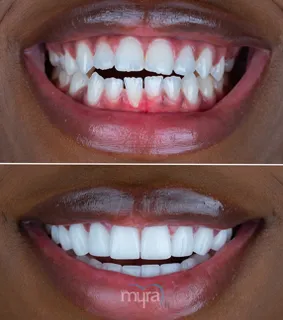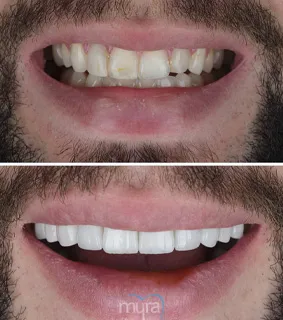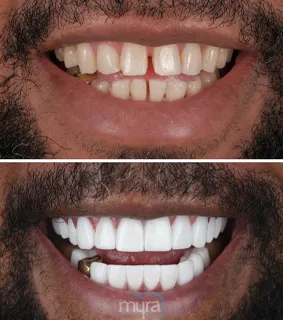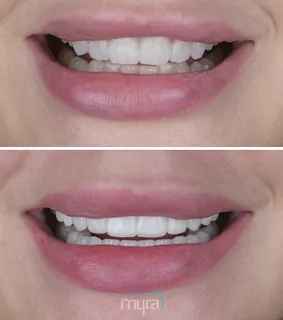Gum shields, known as mouth guards or mouth protectors, are protective devices worn over the teeth and gums to shield them from injury during sports and physical activities. A clear mouth guard is made from flexible materials such as thermoplastic or silicone and is custom-fitted to the wearer's dental anatomy for optimal comfort and protection. The primary purpose of a gum shield is to absorb and distribute the force of impacts to the mouth, reducing the risk of dental and facial injuries such as broken teeth, lacerations, and concussions.
The importance of wearing a gum shield is balanced, especially for individuals engaged in contact sports or activities with a risk of impact to the face or mouth. Dental injuries are painful, costly to treat, and result in long-term complications such as tooth loss or damage to the underlying bone structure. Gum shields help minimise the risk of such injuries and promote oral health and safety by providing a protective barrier between the teeth and hazards.
Gum shields are available at varying price points depending on factors such as material quality, customisation options, and additional features in terms of cost. Custom-fitted gum shields crafted by a dental professional offer superior fit, comfort, and protection, albeit at a higher price, while essential boil-and-bite mouthguards are relatively inexpensive and readily accessible. However, investing in a custom-fitted gum shield improves performance, durability, and peace of mind during sports and physical activities.
One of the critical advantages of wearing a mouth protector is its protection against dental and facial injuries. Gum shields help to reduce the risk of broken teeth, cuts, bruises, and other injuries to the mouth and face by absorbing and dispersing the force of impacts. It enhances comfort and confidence for the wearer, allowing them to focus on their performance without worrying about injuries.
Gum shields have some disadvantages despite their numerous benefits. For example, poorly fitted or bulky gum shields interfere with speech, breathing, and comfort, leading to potential discomfort or distraction during sports. Furthermore, inadequate cleaning and maintenance of the gum shield increase the risk of bacterial growth, oral infections, and hygiene issues, underscoring the importance of proper care and hygiene practices.
Obtaining a gum shield involves visiting a dental professional who takes impressions of the wearer's teeth to create a custom-fitted mouth guard in terms of procedure. Boil-and-bite mouthguards are purchased over the counter and moulded to fit the wearer's teeth using hot water. Proper fitting and adjustment of the mouth guard dental are essential to ensure optimal comfort, protection, and performance during sports and physical activities.
What is Gum Shield?
A gum shield, known as a mouthguard, is a protective device for the mouth that covers the teeth and gums to prevent and reduce injury to the teeth, arches, lips, and gums. A gum shield is commonly used in contact sports, such as boxing, football, hockey, and martial arts, to help prevent oral injuries during physical activity. Using a gum shield is essential in sports with a high risk of impact to the face, offering protection against broken teeth, jaw injuries, and cuts to the lips and mouth.
Gum shields are made from various materials, including thermoplastic, silicone, or rubber, and are categorised into three main types such as stock mouthguards, boil-and-bite mouthguards, and custom-fitted mouthguards. Stock mouthguards are pre-formed and ready to wear, offering a quick and inexpensive option, though their fit and comfort are better. Boil-and-bite mouthguards, made from thermoplastic material, are softened in hot water and then formed to the contours of the user's teeth and gums by applying pressure with the fingers and tongue.
Custom-fitted mouthguards are individually designed and made in a dental office or a professional laboratory based on a dentist's instructions. Custom-fitted mouthguards provide the best protection, fit, and comfort as they are tailored to the individual's dental anatomy, although more expensive.
The effectiveness of a gum shield in protecting oral health during sports activities is not overstated. A gum shield significantly reduces the severity of injuries by absorbing and distributing the force of an impact. Research has suggested that mouthguards reduce the risk of concussion by absorbing shock and preventing the jaw from transmitting forces to the brain. Given the potential for dental injuries, associated costs, and discomfort, a proper mouthguard is considered a critical component of athletic gear for amateur and professional sports participants.
A gum shield is an essential protective equipment in sports and recreational activities involving physical contact or the risk of impact to the face. Athletes significantly reduce their risk of oral injuries, making the gum shield a fundamental part of their sporting kit by choosing the appropriate type and ensuring a proper fit.
What is the Purpose of Gum Shield?
The purpose of a gum shield is multifaceted, primarily focusing on protecting the oral cavity during physical activities that carry a risk of impact to the face. The protective device is designed to safeguard the teeth, gums, lips, and arches from injury, ranging from minor cuts and bruises to more severe cases such as tooth avulsion, fractures, and jaw injuries. A gum shield acts as a barrier that absorbs and distributes the force of impact covering the upper teeth and gums, significantly reducing the chances and severity of oral injuries.
Gum shields play a crucial role in preventing concussions and other types of head injuries beyond the essential protection of dental structures. The cushioning effect provided by a properly fitted gum shield helps absorb shock and reduce the force transmitted from the jaw to the skull, potentially lowering the risk of concussion. Protection is essential in high-contact sports such as football, hockey, boxing, and martial arts, where the risk of concussive forces to the head is significant.
Gum shields contribute to the confidence and performance of athletes. Players focus more on their performance without the constant fear of injury, knowing they are protected against dental and facial injuries. The psychological benefit enhances the sporting experience, allowing athletes to engage more freely and aggressively in their respective sports.
Sports organisations and educational institutions mandate the use of a gum shield to ensure the safety of participants, in addition to its protective functions. Compliance with these regulations helps protect the individual athlete and standardised safety measures across teams and leagues, promoting a sports injury prevention culture.
The purpose of a gum shield extends beyond merely protecting the teeth and gums. It is a critical piece of safety equipment that offers a comprehensive approach to preventing oral injuries, reducing the risk of concussions, enhancing athlete confidence and performance, and complying with sports safety regulations. The gum shield is an indispensable part of an athlete’s gear, essential for anyone participating in activities with a risk of impact to the face through its multifunctional role.
What is the importance of Gum Shield?
The importance of a gum shield lies in providing essential protection to athletes during sports and recreational activities that involve physical contact or the risk of facial impact. A gum shield is a critical equipment designed to cushion and absorb shock, significantly reducing the potential for dental injuries. These include chipped or broken teeth, nerve damage, tooth loss, and injuries to the lips and gums. Gum shields help to mitigate the severity of injuries that otherwise lead to painful, expensive, and time-consuming dental treatments by distributing the force of an impact more evenly across the mouth.
Gum shields are pivotal in protecting against oral and dental injuries and play a significant role in preventing concussions and other brain injuries. The cushioning effect provided by a well-fitted gum shield lessens the force transmitted from a blow to the jaw up to the skull and brain. It offers an additional layer of safety against concussions, which are a significant concern in contact sports. The protective benefit underscores the importance of gum shields in athlete health and safety, extending beyond oral protection to prevent more severe head injuries.
The importance of gum shields extends to athletes' psychological well-being and performance. Knowing that they are adequately protected allows athletes to concentrate on their performance without the distraction and fear of injury. The confidence leads to better performance and a more enjoyable sporting experience. Using gum shields instils professionalism and discipline in athletes, as adhering to safety protocols is a fundamental aspect of sports ethics and responsibility.
Gum shields are essential for compliance with sports regulations and policies. Sports organisations and leagues require mouthguards as part of their safety protocols, making gum shields indispensable for athletes who wish to compete. The regulatory aspect highlights the recognised value of gum shields in promoting safety in sports, ensuring that athletes are protected according to standardised safety measures.
The importance of a gum shield transcends its primary function of protecting the mouth and teeth. It is crucial in preventing serious injuries, supporting athletes' confidence and performance, and complying with sports safety standards. Gum shields represent a vital component of sports safety gear, emphasising the broader commitment to health and safety in athletic participation.
Who is a good candidate for Gum Shields?
A good candidate for a gum shield is an individual at risk of sustaining facial, dental, or head injuries through their activities, whether they are sports-related or not. These candidates include children, adolescents, and adults participating in contact and some non-contact sports, individuals with orthodontic appliances, and people involved in any physical activities with a potential risk of injury to the mouth or face. The broad applicability of gum shields underscores their importance as a preventive tool for a wide range of individuals, emphasising the need for protection across various contexts.
A good candidate for a gum shield is an individual engaging in activities with a risk of impact on the face, mouth, or head. The candidates include participants in various sports, from high-contact team sports such as football, hockey, and rugby to individual sports, involving boxing, martial arts, and even some non-contact sports where accidental impacts occur. Accidental impacts occur in non-contact sports including basketball, skateboarding, and gymnastics. Athletes in these sports are at a higher risk of sustaining dental and facial injuries, making gum shields essential protective equipment.
Children and adolescents participating in sports and recreational activities are excellent candidates for gum shields, given their susceptibility to dental injuries during their developmental years. Schools, youth leagues, and sports clubs often require gum shields for young athletes to promote safety from an early age. However, adults participating in amateur and professional sports must consider gum shields critical for their protective gear, as the risk of oral injuries does not diminish with age.
Individuals with orthodontic appliances, such as braces are excellent candidates for gum shields. Special orthodontic mouthguards protect the appliance and the mouth. These specialised gum shields help prevent injuries that the appliance causes during an impact, such as cuts to the lips and cheeks, and protect against potential damage to the orthodontic work.
Individuals engaged in non-sporting activities that pose a risk to the teeth and face, such as certain types of physical jobs or hobbies involving facial trauma, benefit from wearing a gum shield. A gum shield serves as a preventive measure to safeguard against unexpected injuries.
Can a gum shield be used for sports?
Yes, a gum shield can be used for sports. A gum shield is highly recommended and required for many athletic activities. Gum shields are designed to protect the teeth, gums, and mouth from injuries that occur during sports, especially in contact sports such as football, hockey, rugby, martial arts, and boxing. They help to absorb and distribute the impact that otherwise causes severe dental injuries, such as broken teeth, jaw injuries, and lacerations to the gums and soft tissues of the mouth.
A gum shield is equally essential for athletes who wear dentures. The gum and surrounding tissues need protection from impacts that cause soreness, bruising, or damage to the dentures, while dentures replace missing teeth. An adequately fitted gum shield provides protection, allowing individuals with dentures to participate in sports with an added level of safety. These athletes must consult a dental professional to ensure their gum shield fits correctly over their dentures, providing comfort and adequate protection.
Gum shields are for high-impact sports. Athletes in non-contact sports or activities with a risk of falling or flying equipment, such as skateboarding, mountain biking, or basketball, benefit from wearing a gum shield. Its protection against accidental impacts prevents a wide range of dental injuries, making it a valuable piece of equipment for any athlete.
Using a gum shield in sports is a proactive measure to safeguard oral health and applies to athletes of all ages and levels, including athletes who wear dentures. Athletes significantly reduce their risk of dental and facial injuries by wearing a gum shield, making it an essential part of their sporting gear.
Is it safe for people with Dentures to wear Gumshield?
Yes, it is safe for people with dentures to wear a gum shield, but with specific considerations. Individuals with dentures benefit from wearing gum shields during sports or activities that pose a risk of impact to the face, helping to protect their mouths and the investment they have made in their dentures. However, get a gum shield that fits appropriately over their dentures or, if they wear partial dentures, to ensure the gum shield accommodates their specific dental situation.
A gum shield used by someone with dentures must ideally be custom-fitted by a dental professional. It ensures that the gum shield provides adequate protection without causing damage to the dentures or discomfort to the wearer. The custom fitting process involves creating a mould of the mouth and dentures, which is then used to craft a gum shield that fits the unique contours of the wearer's mouth. The level of customisation helps evenly distribute the force of any impact, offering adequate protection while minimising the risk of injury.
Individuals with dentures must maintain good oral hygiene when using a gum shield. They must regularly clean their dentures and the gum shield to prevent bacteria buildup and ensure both remain in good condition. They must inspect their gum shield for signs of wear and tear over time and replace it when necessary to maintain optimal protection.
People with dentures safely wear a gum shield during sports and activities with a risk of facial impact. Individuals with dentures protect their mouths and dentures effectively, ensuring they participate in their chosen activities confidently and safely by opting for a custom-fitted gum shield and maintaining proper hygiene practices.
How Does Gum Shield Work?
Gum shields provide a protective barrier between the teeth, gums, and soft tissues of the mouth and any impact during physical activities, particularly sports. A gum shield absorbs and disperses the force of impacts when properly fitted and worn, reducing the risk and severity of injuries such as broken teeth, jaw fractures, and lacerations to the gums and lips. The construction of a gum shield, made from durable materials, including thermoplastic or silicone, allows it to conform to the shape of the wearer's teeth and gums, providing a comfortable yet secure fit.
The gum shield must first be appropriately fitted to the wearer's mouth to use a gum shield effectively. It is achieved through various methods, including boil-and-bite mouthguards, softened in hot water and then moulded to the individual's teeth and gums, or custom-fitted mouthguards crafted by dental professionals based on impressions of the wearer's mouth. The gum shield must be worn during any activity where there is a risk of impact to the face once fitted, including contact sports, such as football, hockey, and martial arts, as well as non-contact sports where accidental collisions occur.
A gum shield acts as a shock absorber, dissipating the energy of impacts and reducing the force transmitted to the teeth and surrounding tissues during use. It helps to prevent dental injuries such as tooth fractures and dislocations and soft tissue injuries, involving lacerations and bruising. An adequately fitted gum shield helps to reduce the risk of concussion by cushioning the jaw and absorbing some of the forces that otherwise be transmitted to the skull.
Regular maintenance of a gum shield is essential to ensure its continued effectiveness. The gum shield must be cleaned thoroughly with soap and water or a mouthguard cleaning solution to remove any bacteria or debris after each use. It must be stored in a clean, ventilated case to prevent damage and maintain its shape. Periodic inspection for signs of wear and tear, such as cracks or tears in the material, is recommended, and the gum shield must be replaced if any damage is detected to ensure ongoing protection during sports and other activities.
A gum shield provides a protective barrier against the mouth and face impacts during physical activities. A gum shield helps to reduce the risk and severity of dental and facial injuries, making it an essential piece of safety equipment for athletes and individuals participating in sports and recreational activities.
When does the Dentist recommend Gum Shield to their clients?
Dentist recommends gum shields to their clients when there is a risk of dental injury or trauma during physical activities. The recommendation is made during routine dental check-ups or consultations for individuals who participate in contact sports or activities with a chance of facial impact. The dentist assesses the patient's oral health, lifestyle, and activity level to determine if a gum shield protects their teeth, gums, and mouth.
Clients with a history of dental injuries or undergoing extensive dental work, such as crowns, bridges, or orthodontic treatment, are encouraged to use a gum shield. These individuals are at a higher risk of experiencing complications or damage to their dental work if they sustain an impact on the mouth, making a gum shield an essential preventive measure to safeguard their investment in oral health.
Individuals with bruxism (teeth grinding) or temporomandibular joint (TMJ) disorders benefit from using a gum shield. A gum shield helps cushion and distribute the forces generated by clenching or grinding the teeth and protects against external impacts, reducing the risk of further damage or exacerbation of these conditions.
The general dentist recommends a specialised orthodontic gum shield to protect the teeth and the appliances from damage during sports or physical activities for patients undergoing orthodontic treatment, such as braces or clear aligners. These gum shields are designed to accommodate orthodontic appliance brackets, wires, and attachments while protecting against impacts adequately.
Dentists proactively recommend dental shields to clients to prevent dental injuries and maintain oral health. The general dentist promotes patient safety and well-being inside and outside the dental office by identifying at-risk individuals and customising recommendations based on their unique needs and circumstances.
What Are the Signs that Indicate a Gum Shield May Need Replacement?
The Signs that Indicate a Gum Shield may Need Replacement are listed below.
- Visual Damage: Check the gum shield regularly for cracks, tears, or holes in the material. The gum shield degrades after repeated use, impairing its ability to provide adequate protection.
- Changing Fit or Comfort: Gum shields become distorted or warped if they do not fit snugly against the teeth or gums or feel uncomfortable to wear. Gum shields do not absorb impact if not fitted properly, increasing the risk of injury.
- Symptoms of Decay: Decay symptoms include persistent odour or taste emanating from the gum shield, even after cleaning. Due to hygienic concerns, the gum shields no longer protect against oral infections or injuries.
- Cleaning Difficulty: The gum shield becomes increasingly difficult to clean or develops stubborn stains that are not removed over time if the material deteriorates or absorbs bacteria. The importance of maintaining oral hygiene and preventing infections is not overstated.
- Shape or Structure Irregularities: A gum shield's shape or structure, such as warping, thinning, or uneven thickness, compromises its protective capabilities. The irregularities appear gradually over time as a result of exposure to extreme temperatures or as the result of improper storage.
- Recurring Dental Injuries or Discomfort: A dental injury or discomfort that occurs frequently despite wearing a gum shield indicates that one is no longer getting adequate protection from the gum shield. A replacement gum shield is necessary in such cases, depending on the fit and condition of the gum shield.
What is the Procedure for a Gum Shield?
The Procedure of Gum Shield is listed below.
- Begin with a consultation. The process begins with a consultation with a dental professional, such as a general dentist or orthodontist. The patient discusses their needs and concerns regarding using a gum shield during the consultation. The dental professional evaluates the patient's oral health, dental history, and specific requirements to determine the most suitable gum shield type.
- Take impression or moulding. The dental professional takes impressions or moulds of the patient's teeth and gums once the decision is made to proceed with a gum shield. The step involves placing a soft, putty-like material into a tray that is then inserted into the mouth to create an imprint of the teeth and surrounding tissues. Gum shields, such as boil-and-bite mouthguards, allow for self-moulding at home by softening the material in hot water and then biting down to create a customised fit.
- Fabrication of gum shield using specialised materials. Using the impressions or moulds obtained, the gum shield is fabricated using specialised materials such as thermoplastic, silicone, or rubber. Custom-fitted gum shields are manufactured in a dental laboratory or office, where the gum shield is carefully crafted to match the unique contours of the patient's mouth.
- Fitting and adjustments. The patient returns to the dental professional for a fitting appointment. The gum shield is checked for fit and comfort, and any necessary changes are made to ensure a snug and secure fit during the appointment. The dental professional trims or adjusts the gum shield as needed to eliminate any sharp edges or areas of discomfort.
- Instructions for use and care. The dental professional provides the patient with instructions for using and caring for the gum shield. It includes guidance on adequately inserting and removing the gum shield, how often to wear it, and how to clean and store it between uses. Patients must follow these instructions carefully to maintain the effectiveness and longevity of the gum shield.
What are the types of Gum shields?
The types of Gum shields are listed below.
- Stock mouthguards: Stock mouthguards are pre-formed and ready to wear without customisation. They are inexpensive and readily available at sporting goods stores or pharmacies. It does not provide the best fit or comfort since they are not tailored to the individual's mouth and offers limited protection compared to other gum shields.
- Boil-and-bite mouthguards: Boil-and-bite mouthguards are made from a thermoplastic material that softens when heated in boiling water. The wearer bites down on the mouthguard, allowing it to conform to the shape of their teeth and gums once softened. The gum shield type offers a more customised fit than stock mouthguards and provides better protection and comfort. Boil-and-bite mouthguards are available at sporting goods stores and are adjusted at home by following the manufacturer's instructions.
- Custom-fitted mouthguards: Custom-fitted mouthguards are individually crafted to fit the unique contours of the wearer's mouth. They are fabricated by a dental professional using impressions or moulds of the patient's teeth and gums. Custom-fitted mouthguards offer the highest level of fit, comfort, and protection since they are explicitly tailored to the individual's dental anatomy. Custom-fitted mouthguards provide superior performance and are recommended for athletes and individuals seeking optimal oral protection during sports and other activities while more expensive than stock or boil-and-bite mouthguards.
Can you customise a gum shield?
Yes, you can customise a gum shield. Customised gum shields provide a better fit and optimal protection for the wearer. Customisation involves crafting the gum shield to match the unique contours of the individual's teeth and gums, resulting in a more comfortable and secure fit than stock or boil-and-bite mouthguards.
The customisation begins with taking impressions or moulds of the wearer's mouth, which capture the precise shape and size of their teeth and gums. These impressions are then used to fabricate a gum shield tailored to the individual's dental anatomy.
The dental professional uses specialised materials such as thermoplastic, silicone, or rubber to create the gum shield during fabrication. These materials are selected based on durability, flexibility, and comfort, ensuring that the customised gum shield meets the wearer's needs and preferences.
Gum shields are carefully fitted and adjusted to ensure a snug and comfortable fit once the gum shield is fabricated. Any necessary modifications are made to achieve the desired fit and feel, such as trimming or reshaping the gum shield to eliminate sharp edges or areas of discomfort.
Customisation allows for a personalised approach to oral protection, ensuring that the gum shield conforms precisely to the wearer's mouth for maximum comfort and effectiveness. They offer superior fit, comfort, and safety, making them ideal for athletes and individuals seeking optimal oral protection during sports and other activities, while custom-fitted gum shields are more expensive than stock or boil-and-bite mouthguards.
How do you properly fit a gum shield?
You must properly fit a gum shield by following the steps listed below.
- Boil water. Bring a pot of water to a boil on the stove. Remove it from the heat source once the water reaches a rolling boil.
- Prepare the gum shield. Place the gum shield in the boiled water for the specified time indicated in the manufacturer's instructions if using a boil-and-bite mouthguard. The step softens the thermoplastic material, making it pliable for moulding.
- Prepare a bowl of cold water with ice cubes while the gum shield softens in the boiled water. It is used to cool the gum shield quickly after moulding.
- Remove the gum shields from water. Carefully remove the gum shield from the boiled water and allow it to cool slightly for a few seconds using tongs or a spoon to prevent burns.
- Place it in the mouth and bite down firmly but gently once the gum shield has cooled slightly but is pliable. Use fingers and tongue to press the gum shield against the teeth and gums, ensuring a snug and secure fit.
- Shape the gum shield. Use fingers to press the gum shield against the contours of the teeth and gums, moulding it to fit the shape of the mouth while biting down. Pay special attention to areas where the gum shield needs additional shaping or adjustment.
- Cool the gum shield. Immediately immerse it in the bowl of cold water for a few seconds to cool and harden the material after shaping the gum shield. It sets the shape of the gum shield and ensures it maintains its customised fit.
- Check the fit. Remove the gum shield from the cold water and try it on to ensure it fits securely and comfortably in the mouth. Make any necessary adjustments by repeating the moulding process as needed.
- Trim it with scissors according to the manufacturer's guidelines if the gum shield extends too far back into the mouth or feels uncomfortable against the gums. Be careful not to trim too much, as it compromises the protection offered by the gum shield.
- Rinse it thoroughly with water before using it for sports or other activities once an individual is satisfied with the fit and comfort of the gum shield. Clean the gum shield regularly to maintain proper hygiene and prolong its lifespan.
How often should you replace a gum shield?
The frequency of how often you should replace a gum shield is listed below.
- Regular Use: The frequency of replacing a gum shield depends on how often it is used and exposed to wear and tear. Replacing the gum shield more frequently is necessary to ensure optimal protection. Occasional or infrequent use allows the gum shield to last longer before needing replacement.
- Regular Inspection: Inspect the gum shield for signs of wear and tear, damage, or deterioration. Look for any visible signs, such as cracks, tears, holes, or irregularities in the shape or structure of the gum shield. It is time to replace the gum shield when noticing these signs.
- Change in Fit or Comfort: A gum shield that no longer fits snugly against the teeth and gums or feels uncomfortable to wear indicates that it has become distorted, warped, or worn out. Changes in fit or comfort can compromise the effectiveness of the gum shield and increase the risk of injury, so replace it when experiencing any discomfort or difficulty wearing it.
- Dental changes: Changes in the wearer's dental anatomy, such as tooth movement, growth, or loss, affect the fit and effectiveness of the gum shield. Replace the gum shield to ensure a proper fit and protection when undergoing significant dental changes, such as braces or orthodontic treatment.
- Hygiene Considerations: Proper cleaning and maintenance are essential for prolonging the lifespan of a gum shield and preventing the buildup of bacteria, mould, or odours. It indicates that the gum shield needs replacement to maintain proper hygiene and oral health when having difficulty cleaning it or noticing persistent foul odours or tastes.
Are there specific cleaning instructions for a gum shield?
Yes, there are specific cleaning instructions for a gum shield to ensure proper hygiene and prolong its lifespan. Rinse the gum shield thoroughly with cool water to remove saliva, bacteria, and debris after wearing the gum shield during sports or physical activities. It helps prevent the buildup of odour-causing bacteria and maintains oral hygiene.
Use a mild soap or dishwashing liquid and lukewarm water to clean the gum shield after each use. Gently scrub the gum shield with a soft-bristled toothbrush or clean fingers, paying attention to all surfaces, including the inside and outside. Do not use hot water to clean the gum shield, as it causes the material to warp, distort, or lose shape. Stick to lukewarm or cool water when cleaning the gum shield to avoid damaging it.
Avoid using abrasive cleaners, harsh chemicals, or alcohol-based mouthwash to clean the gum shield, as these damage the material and compromise its effectiveness. Stick to mild soap and water for gentle yet effective cleaning.
Allow the gum shield to air dry completely before storing it in its case or container after cleaning. Avoid storing the gum shield in a damp or humid environment, as it promotes the growth of bacteria and mould. Store the gum shield in its case or container to protect it from dust, dirt, and damage when not in use. Ensure the storage container has ventilation holes to allow air circulation and prevent moisture buildup.
Avoid chewing on it or biting down excessively to prolong the lifespan of the gum shield, as it causes premature wear and tear. Maintain proper hygiene and prolong the lifespan of the gum shield by following these cleaning instructions, ensuring continued effectiveness and protection during sports and other activities. Regular cleaning and maintenance are essential for keeping the gum shield clean, odour-free, and in good condition for optimal oral health.
How do you store a gum shield when it's not in use?
You must store a gum shield when not in use by following the steps listed below.
- Use a protective case. Store the gum shield in a dedicated protective case or container designed for its purpose. Many gum shields include a case or container, but if not, purchase one separately. The case helps to protect the gum shield from dust, dirt, and damage when not in use.
- Choose a storage case with holes or slots to allow air circulation. Proper ventilation helps to prevent moisture buildup inside the case, which leads to the growth of bacteria and mould on the gum shield.
- Clean and dry before storing. Ensure the gum shield is clean and not scorched before storing it. Rinse it thoroughly with cool water and mild soap, and then air dry it thoroughly before placing it in the storage case. Avoid storing a damp gum shield, promoting bacterial growth and odour.
- Avoid exposure to heat and sunlight. Store the gum shield in a cool, dry place away from direct sunlight and heat sources, such as radiators or heaters. Exposure to heat causes the gum shield to warp, distort, or lose shape, compromising its effectiveness and fit.
- Keep pets and children away from the gum shield storage. Store the gum shield out of reach of pets and young children to prevent accidental damage or ingestion. Gum shields are made from harmful materials if chewed or swallowed, so keep them safely stored away when unused.
- Clean the storage case. Periodically clean the storage case or container with mild soap and water to remove any dirt, bacteria, or debris accumulated over time. It helps to maintain proper hygiene and ensures the gum shield remains clean and protected when stored.
What are the Advantages of Gum Shield?
The Advantages of Gum Shield are listed below.
- Comfort and Fit: Gum shields offer a comfortable and secure fit that allows for natural breathing and speaking without hindrance when properly fitted. Custom-fitted gum shields provide a snug and precise fit that contours to the wearer's teeth and gums, maximising comfort and protection during sports and other activities.
- Compliance with Safety Regulations: Sports organisations, leagues, and schools require using gum shields as part of their safety protocols for participants. Athletes comply with these regulations by wearing a gum shield and protecting themselves against dental and facial injuries during sports and other activities.
- Dental Protection: One of the primary advantages of gum shields is their ability to protect the teeth, gums, and mouth from injuries during sports and other activities. By absorbing and distributing the force of impacts, gum shields help to prevent dental injuries such as broken teeth, tooth avulsion, fractures, and lacerations to the gums and soft tissues of the mouth.
- Facial Protection: Gum shields provide security for the face and jaw in addition to dental protection. They help to reduce the risk and severity of facial injuries such as fractures, concussions, and cuts to the lips and cheeks, which occur due to accidental collisions or impacts during sports and physical activities.
- Prevention of Concussions: Gum shields help to reduce the risk of concussions and other head injuries by cushioning the jaw and absorbing some forces transmitted to the skull during impacts. Gum shields provide an additional layer of safety against concussive forces, particularly in contact sports, while not being a substitute for proper head protection.
- Customisation Options: Gum shields are available in various types and designs to suit individual preferences and requirements. Wearers choose the type of gum shield that best fits their needs in terms of fit, comfort, and level of protection, whether stock, boil-and-bite, or custom-fitted. Gum shields are customised with team colours, logos, or personalisation for added style and identity.
Can a gum shield prevent concussions?
No, a gum shield cannot prevent concussions. Gum shields are not explicitly designed to prevent concussions, while gum shields provide some level of protection against dental and facial injuries. Concussions occur when the brain is subjected to rapid acceleration or deceleration, causing it to move within the skull and resulting in injury. Gum shields primarily cushion the teeth and jaw, absorbing and dispersing the force of impacts to reduce the risk of dental and facial injuries. However, they do not offer the same level of protection for the brain as specialised helmets or headgear explicitly designed for concussion prevention.
Research suggests that gum shields indirectly help reduce the risk of concussions by providing additional padding and support to the jaw. Gum shields help mitigate the risk of concussive forces by cushioning the jaw and absorbing some forces transmitted to the skull during impacts. However, the effect is not guaranteed, and gum shields alone do not provide comprehensive protection against concussions.
Athletes must use appropriate headgear and helmets to prevent concussions, especially in high-contact sports, including football, hockey, and rugby. These helmets are engineered to absorb and dissipate the forces of impact, reducing the risk of head injuries and concussions. Athletes must follow proper techniques and guidelines for safe play, undergo regular medical evaluations, and be educated about the signs and symptoms of concussions. It minimises the risk of injury during sports and physical activities, in addition to wearing protective headgear.
What are the Disadvantages of Gum Shield?
The Disadvantages of Gum Shield are listed below.
- Breathing Difficulties: Wearers experience difficulty breathing or reduced airflow while wearing it, depending on the fit and design of the gum shield. It is problematic during strenuous physical activity, as inadequate airflow leads to discomfort, fatigue, and decreased performance.
- Communication Difficulties: A poorly fitted or bulky gum shield interferes with speech, making it difficult for wearers to communicate effectively during sports or other activities. Slurred speech or difficulty articulating words impact teamwork, coordination, and performance on the field or court.
- Inflammation and Discomfort: Gum shields that do not fit properly or are made from rigid or uncomfortable materials cause irritation, soreness, or even cuts to the gums, lips, or cheeks. Prolonged wear of an ill-fitting gum shield leads to discomfort, distraction, and reluctance to wear the protective gear, compromising its effectiveness in preventing injuries.
- Misalignment of the Jaw: Wearing a gum shield contributes to jaw misalignment or temporomandibular joint (TMJ) discomfort in some cases, especially if the gum shield is too thick or forces the jaw into an unnatural position. Chronic misalignment or TMJ issues lead to jaw pain, headaches, and other dental or musculoskeletal problems over time.
- Fitting Difficulty: Custom-fit gum shields are more expensive and time-consuming than stock or boil-and-bite mouthguards, while custom-fitted gum shields offer the best fit and comfort. Obtaining a custom-fitted gum shield requires multiple appointments with a dental professional and involves additional costs, disadvantaging some athletes or individuals.
- Buildup of Bacteria: Gum shields become a breeding ground for bacteria, mould, and odour-causing microbes without proper cleaning and maintenance. Prolonged use of a dirty or unsanitary gum shield increases the risk of oral infections, bad breath, and oral hygiene issues.
How Long Does the Gum Shield Would Last?
The gum shield would last between one and three years. The lifespan of a gum shield varies depending on several factors, including the type of gum shield, frequency of use, level of care and maintenance, and the wearer's dental habits. A well-maintained gum shield lasts from one to three years with regular use. However, some gum shields must be replaced more frequently, especially if they are subjected to heavy wear and tear or changes in the wearer's dental anatomy.
Custom-fitted gum shields are individually crafted to match the wearer's dental contours and last longer than stock or boil-and-bite mouthguards. Custom-fitted gum shields offer a precise fit and optimal protection, reducing the risk of discomfort, irritation, or damage to the gums and teeth. A custom-fitted gum shield lasts up to three years or more before needing replacement with proper care and maintenance.
Stock or boil-and-bite mouthguards have a shorter lifespan due to their less precise fit and lower-quality materials. Stock mouthguards, which come pre-formed and ready to wear, must be replaced more frequently as they wear out or lose shape over time. Boil-and-bite mouthguards degrade faster with repeated use and exposure to heat while customisable to some extent.
Factors that affect the lifespan of a gum shield include the wearer's dental hygiene habits, storage practices, and the intensity of sports or physical activities in which the gum shield is worn. Regular cleaning, proper storage in a ventilated case, and avoiding exposure to extreme temperatures help prolong the lifespan of a gum shield and maintain its effectiveness over time.
Wearers must regularly inspect their gum shields for wear and tear, damage, or deterioration. It is time to replace the gum shield if it shows signs of damage, discomfort, or changes in fit to ensure continued protection and comfort during sports and other activities. Wearers maximise the lifespan of their gum shield and provide optimal oral protection by replacing the gum shield as needed and following proper care and maintenance practices.
What are the Possible Complications of Having Gum Shields?
The possible complications of having gum shields revolve around fitness, comfort, and oral health issues. One complication is discomfort or irritation caused by an ill-fitting gum shield. A gum shield rubs against the mouth's soft tissues, leading to soreness, redness, or even cuts and abrasions if the gum shield does not conform properly to the wearer's teeth and gums. Prolonged wear of an uncomfortable gum shield results in reluctance, compromising its effectiveness in preventing injuries.
Another complication of gum shields is the risk of jaw misalignment or temporomandibular joint (TMJ) discomfort. It forces the jaw into an unnatural position if the gum shield is too thick or bulky, leading to strain or misalignment of the jaw joint. Chronic misalignment or TMJ issues cause jaw pain, headaches, and other dental or musculoskeletal problems, affecting the wearer's comfort and oral health.
Improperly cleaned or maintained gum shields become a breeding ground for bacteria, mould, and odour-causing microbes. Gum shields accumulate plaque, saliva, and food particles without regular cleaning and proper hygiene practices, increasing the risk of oral infections, bad breath, and oral hygiene issues. Prolonged use of a dirty or unsanitary gum shield contributes to oral health problems such as tooth decay, gum disease, or fungal infections.
Wearing a gum shield that interferes with breathing or speech poses challenges during sports or physical activities. A poorly fitted or bulky gum shield restricts airflow, making it difficult for the wearer to breathe comfortably or communicate effectively. Inadequate airflow leads to fatigue, shortness of breath, and decreased performance, impacting the wearer's ability to perform at their best on the field or court.
Wearers must be aware of the complications and address any issues related to fit, comfort, hygiene, or performance, while gum shields offer valuable protection against dental and facial injuries. Regular inspection, proper cleaning, and timely gum shield replacement help mitigate these complications and ensure optimal safety and comfort during sports and other activities.
Can a gum shield affect speech?
Yes, a gum shield can affect speech if it is poorly fitted or bulky. The size, shape, and material of the gum shield impact the movement of the tongue and lips, which are essential for clear and articulate speech. A gum shield that is too thick or extends too far into the mouth interferes with the tongue's ability to move freely, resulting in speech impediments such as slurred speech or difficulty articulating certain sounds.
Wearing a gum shield creates a sensation of bulkiness or obstruction in the mouth, which affects the wearer's ability to enunciate words. It is noticeable during sports or physical activities when the wearer exerts themselves and needs to communicate quickly and effectively with teammates or coaches. Not all gum shields affect speech to the same extent. Custom-fitted gum shields, individually crafted to match the wearer's dental contours, offer a more precise fit and better comfort, minimising the impact on speech compared to stock or boil-and-bite mouthguards.
The extent of the effects depends on factors such as the gum shield's fit, design, and material. Wearing a gum shield slightly affects speech as the wearer adjusts to the sensation. Wearers adapt to wearing a gum shield without significant speech impediments, allowing them to communicate effectively with proper fitting and adjustment during sports and other activities.
Could gum shield be the cause of gingivitis?
Yes, gum shields could be the cause of gingivitis if not correctly cleaned and maintained. Gingivitis is a common form of gum disease characterised by inflammation of the gums, leading to redness, swelling, tenderness, and bleeding. Prolonged use of a dirty or unsanitary gum shield creates an environment conducive to bacterial growth, plaque accumulation, and oral infections, increasing the risk of gingivitis.
A gum shield creates an ideal breeding ground for bacteria to thrive wearing a gum shield, as saliva, bacteria, and food particles become trapped between the gum shield and the teeth. Bacteria multiply and spread to the gums, leading to inflammation and gingivitis if the gum shield is not cleaned regularly or is stored in a damp or unclean environment. Wearing a gum shield that does not fit properly or causes irritation to the gums further exacerbates the risk of gingivitis by causing damage to the gum tissue and disrupting the natural balance of oral bacteria.
Practise good oral hygiene habits and maintain proper care of the gum shield to minimise the risk of gingivitis while wearing a gum shield. It includes cleaning the gum shield thoroughly after each use with mild soap and water, allowing it to air dry completely before storing it in a clean, ventilated case. Regularly inspecting the gum shield for signs of wear and tear, damage, or bacterial buildup is essential to ensure optimal oral health and prevent gingivitis. Wearers minimise the risk of gingivitis associated with wearing a gum shield by taking these precautions and addressing any issues related to fit, comfort, or hygiene.
What are the Materials used in making Gum Shields?
The Materials used in making Gum Shield are listed below.
- Silicone: Silicone is another popular material for making gum shields for custom-fitted mouthguards. Silicone gum shields offer a soft and flexible feel, providing excellent cushioning and shock absorption during impacts. Silicone is hypoallergenic and resistant to bacteria, making it a suitable choice for individuals with sensitive gums or allergies.
- Rubber: Natural rubber is occasionally used in constructing gum shields, although it has become less common due to concerns about latex allergies. Rubber gum shields offer a soft and pliable texture, providing cushioning and impact absorption. However, individuals with latex allergies must avoid gum shields made from rubber and opt for alternative materials instead.
- Composite Materials: Gum shields are made from composite materials that combine multiple layers or types of materials to achieve specific performance characteristics. For example, a composite gum shield consists of a soft inner layer for cushioning and comfort and a more rigid outer layer for added protection and durability.
- Polyurethane: Polyurethane is a durable and resilient material sometimes used to fabricate high-performance gum shields. Polyurethane gum shields offer excellent impact resistance and long-lasting durability, making them suitable for athletes and individuals participating in high-contact sports.
- Thermoplastic Materials: Thermoplastic materials such as ethylene vinyl acetate (EVA), polyethene, and polyvinyl chloride (PVC) are commonly used to fabricate gum shields. These materials are flexible, durable, and easy to mould when heated, making them ideal for boil-and-bite mouthguards customised to fit the wearer's teeth and gums. Thermoplastic gum shields offer a comfortable fit and protection against dental and facial injuries.
What is the average price of a Gum Shield?
The average price of a Gum Shield is between £5 to £50. The average cost of a gum shield varies depending on the material, customisation options, and brand. Bare boil-and-bite gum shields, readily available at sporting goods stores or pharmacies, tend to be more affordable, ranging from £5 to £20. These gum shields are moulded to fit the wearer's teeth using hot water and offer essential protection against dental and facial injuries during sports and physical activities.
Custom-fitted gum shields are more expensive due to the personalised fit and higher-quality materials and are individually crafted by a dental professional based on impressions of the wearer's teeth. The cost of a custom-fitted gum shield ranges from £30 to £50 or more, depending on factors such as the complexity of the fitting process, the material used, and any additional features or customisation options.
Custom-fitted gum shields cost more upfront than boil-and-bite mouthguards because they offer superior comfort, fit, and protection, making them a worthwhile investment for individuals engaged in high-contact sports or activities. Custom-fitted gum shields last longer and provide better value for the wearer regarding oral health and safety.
The average price of a gum shield varies depending on geographical location and market demand. The cost of dental services and products is higher or lower than others, leading to differences in pricing for gum shields in some regions or countries. Discounts or promotions offered by dental practices or retailers affect the average price of gum shields available to consumers.
What Are the Things You Can Do with a Gum Shield?
The Things You Can Do with a Gum Shield are listed below.
- Protect Teeth: Protect the teeth and gums during sports and physical activities. Comply with safety regulations and requirements for specific sports or activities.
- Reduced Dental and Facial Risk: Absorb and distribute impact forces to reduce the risk of dental and facial injuries.
- Customised: Customise the fit of the gum shield for optimal comfort and protection. Customise the appearance of the gum shield with team colours or personalisation.
- Communication: Communicate with teammates and coaches while wearing the gum shield.
- Improved Confidence: Improve confidence and focus by knowing an individual is protected during sports.
Specific activities must be avoided to ensure effectiveness and proper hygiene when wearing a gum shield. Chewing gum while wearing the gum shield is not recommended, as doing so interferes with its fit and compromises its protective capabilities. Eating or drinking while wearing the gum shield must be avoided to prevent the introduction of food particles or liquids that lead to hygiene issues and bacterial growth.
Do not share the gum shield with others without proper cleaning and sanitisation between uses. Sharing a gum shield without adequate hygiene measures increases the risk of transferring bacteria or infections between individuals. Wearing a gum shield that is damaged, ill-fitting, or uncomfortable must be avoided, as it does not provide adequate protection and potentially cause further harm or discomfort.
Using the gum shield as a substitute for other protective equipment, such as helmets or goggles, is not recommended. Each protective gear serves a specific purpose, and relying solely on a gum shield for protection leaves certain areas vulnerable to injury. Use the appropriate protective equipment for the particular activity or sport being performed.
Ignoring signs of wear and tear or changes in the fit of the gum shield is a risk that must be taken seriously. Any deterioration in the condition or fit of the gum shield compromises its effectiveness in protecting against dental and facial injuries. Regularly inspecting and maintaining the gum shield is necessary to ensure it remains in good condition and functions as intended.
Neglecting oral hygiene practices such as brushing and flossing while wearing the gum shield leads to hygiene and oral health problems. Proper oral hygiene is essential for maintaining the health of the teeth, gums, and mouth, even while wearing protective gear. Regular cleaning and maintenance of the gum shield and routine oral care are essential for oral health and hygiene.















